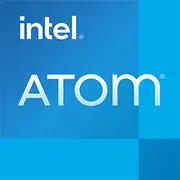Intel Atom N2600

Intel Atom N2600 (Cedarview): Moderate Power for Minimalist Tasks. Review and Recommendations for 2025
Introduction
The Intel Atom N2600 is a processor released in 2012, yet it is still seen in budget and specialized devices. Despite its venerable age, its ultra-low power consumption and compactness keep it relevant for niche scenarios. In 2025, such chips may be found in new entry-level devices (e.g., educational laptops or IoT gadgets) priced between $200 and $300. Let's explore who and why might benefit from this "veteran."
1. Architecture and Technology Process: 32 nm and Modest Ambitions
Known by the codename Cedarview, the processor is built on a 32 nm technology process. It is the second generation of Atom, intended to improve energy efficiency and multimedia capabilities. However, the architecture remains exceedingly simple:
- 2 cores and 4 threads thanks to Hyper-Threading.
- Base frequency is 1.6 GHz, with no turbo mode.
- Integrated graphics (GMA 3600) is built into the NM10 chipset rather than the CPU itself. It supports up to 1080p resolution but only for basic tasks: decoding MPEG2 and H.264 video formats, working with 2D graphics.
Architecture Features:
- Lack of VP8 decoder and limited support for modern codecs.
- Absence of AVX instructions, which is critical for contemporary applications.
- Maximum supported memory is 4 GB DDR3.
2. TDP 4 W: Cold Calculation
The thermal design power (TDP) of 4 W is a key advantage of the Atom N2600. This allows for:
- Operation without active cooling (fan), reducing noise and the thickness of the case.
- Use of compact batteries (e.g., 30-40 Wh) for autonomy of up to 8-10 hours during web surfing.
Limitations:
- Performance is strictly limited by TDP. Under peak load (e.g., running a browser with 10 tabs), possible "lag" may occur.
3. Performance: Realistic Expectations
Results from Geekbench 6 (77 Single-Core, 188 Multi-Core) indicate that the processor in 2025 handles only the simplest tasks:
- Office Work:
- LibreOffice, Google Docs — comfortable use for text and spreadsheets.
- PDF viewing — delays may occur when rendering complex documents.
- Multimedia:
- YouTube: 720p/30fps runs smoothly; 1080p — stutters.
- Local video: HEVC (H.265) format is not supported; conversion to H.264 is required.
- Gaming:
- Older games from the 2000s (Half-Life 2, Minecraft on low settings).
- Modern browser games (e.g., "Among Us") — only on low settings.
Turbo Mode: Absent. Frequency is fixed at 1.6 GHz.
4. Usage Scenarios: Who Will Benefit from N2600 in 2025?
- Educational Laptops: Devices for students (e.g., Digma Eve 3), where price ($220-250) and rugged design are important.
- IoT and Kiosks: Terminals for displaying information, operating 24/7.
- Backup Devices: A laptop "just in case" for travel.
- E-Readers and Text Editors: For example, PocketBook CAD Reader with a keyboard.
Not Suitable For:
- Graphic work (Photoshop, Figma).
- Multitasking (simultaneous running of a browser, messaging apps, and office programs).
5. Autonomy: 10 Hours — Not the Limit?
With a 40 Wh battery and energy-saving settings (brightness 50%, Wi-Fi on), it is possible to achieve 8-10 hours of operation. Technologies that help include:
- Intel SpeedStep — dynamic frequency reduction during idle times.
- C-States — powering down unused components.
Tip: For maximum autonomy, choose models with SSD (not eMMC) and a display on IPS matrix with low power consumption.
6. Comparison with Competitors
- AMD C-60 (2011): 2 cores, TDP 9 W. Better graphics (Radeon HD 6290), but higher power consumption.
- Intel Atom x5-Z8350 (2016): 4 cores, 2 GHz, supports 8 GB RAM. Price is similar, but performance is 30% higher.
- Apple A8 (2014): An outdated chip from the iPhone 6, but Single-Core performance is twice as fast.
Conclusion: The N2600 lags behind even budget processors from 2016-2020, but it has a price advantage for ultra-budget devices.
7. Pros and Cons
Strengths:
- Record low energy consumption.
- Compatibility with lightweight OS (Linux Lite, Chrome OS Flex).
- Low cost of devices.
Weaknesses:
- Does not support modern codecs and encryption standards.
- Maximum of 4 GB RAM.
- No USB 3.0 or Wi-Fi 6.
8. How to Choose a Laptop with Atom N2600 in 2025?
- Type of Device:
- Ultra-portable netbook (11-12 inches, weight up to 1.2 kg). Example: Prestigio Smartbook 141.
- Hybrid tablet with a docking station.
- What to Check:
- SSD instead of eMMC — even 64 GB is sufficient for Linux.
- Display — resolution of 1366x768, matte surface.
- Ports — HDMI for connecting a monitor.
- Price: Do not overpay more than $250 — for this money, you can find devices with Celeron N4020 that offer better performance.
9. Final Conclusion
The Intel Atom N2600 is a processor for those who value price and autonomy over power. In 2025, it should only be considered for:
- Children's laptops with parental control.
- Devices operating in "field conditions" without access to an outlet.
- Projects with minimal cost requirements (e.g., information displays).
Key Benefits:
- A laptop with N2600 guarantees 10 hours of operation and prices like a smartphone.
- Ideal as a secondary device for travel or lectures.
Alternative: If your budget is $300-400, consider laptops with Intel Celeron N4500 or AMD 3020e processors — they are 3-4 times faster while maintaining good battery life.
Basic
CPU Specifications
Memory Specifications
GPU Specifications
Benchmarks
Compared to Other CPU
Share in social media
Or Link To Us
<a href="https://cputronic.com/cpu/intel-atom-n2600" target="_blank">Intel Atom N2600</a>